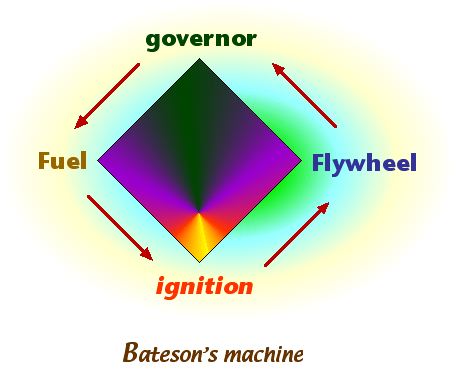

Gregory Bateson was a biological anthropologist and ecologically aware thinker who conceived of any mechanical device as having the above four components. He lived in the 20th century and wrote Steps to an Ecology of Mind and Mind and Nature during the 1970s and 1980s.
He figured that people had to be able to systematically think of machinery as a functional network of parts working in harmony. The above diagram suggests his notion that operationally every mechanical device includes, 1) a source of fuel, 2) an explosive component to affect motion, 3) a device to keep motion occurring in a smooth fashion, 4) a guidance function to assure that extremes of operation (shut down or burnout) are avoided.
Four working parts of machinery with examples are:
As suggested above, real machines can be more complex than this model supposes, but any automotive vehicle can be thought of as possessing these four interactive component parts. In electronic machinery the role of the flywheel is taken over by the constant flow of electrons from one pole of charge to another.
Efficiency and performance of early steam engines, for example, were improved by the use of flywheels and governors to enhance momentum and to modulate the power inherent in the escape of expanding steam from the boiler. The efficiency of the fire in the boiler where water was turned into steam was improved by adding flywheels and governors because flywheels extend the momentum of the machine while the governors moderate the tendency of the mechanical parts to speed up or slow down, thus adding a jerkiness to the steady momentum on which the output depends.
Leo Marx, The Machine in the Garden